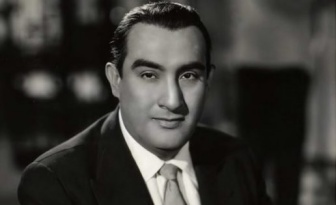Voices to remember: Pedro Vargas
News Category: News, Community News, and General Discussion
-
He was one of the great interpreters of composer Agustín Lara. He was known as the “Nightingale of the Americas” or the “Samurai of Song” and his career spanned from the 1920s until he died of diabetes in Mexico City in 1989 at the age of 83. An artist with great international recognition, he began his training in operatic work and ended up dedicating himself to the interpretation of popular songs.
Born into a family in the town of San Miguel de Allende in the Mexican state of Guanajuato in April 1906, he grew up under the humility of his parents, who had 12 children. As a child, he sang in the church choir and when he was only 7 years old he began to receive singing lessons because he had an innate talent. Sometime later he went to Mexico City to continue his training in serenades until a solfeggio and piano teacher of French origin named Jose Pierno offered him vocal technique lessons after hearing him sing. He was a scholarship student in his secondary and high school studies since he was able to stay for free at the Colegio Francés de La Salle in the city. He was advancing in his techniques until there was a moment in which he felt stagnant since Pierson cataloged him as a Baritone and he did not feel comfortable. Later he left this teacher and went to study singing and stage movement with another great expert, Alejandro Cuevas, on the recommendation of the actor and priest José Mojica. With Cuevas, he also had free lessons and a number of interpretations in Italian and French. Those were times in which Vargas also began to rub shoulders with fellow actors such as Jorge Negrete, Juan Arvizu, and Alfonso Ortiz Tirado until the day of his official debut arrived.
On January 22, 1928, the Esperanza Iris Theater opened its doors to him with “Cavalleria Rusticana”. A magical night that led him to receive several jobs offers such as a tour of the United States with Miguel Lerdo de Tejada’s orchestra as a soloist, or a role with the soprano Ángeles Otein in “The Barber of Seville”. Vargas finally accepted to join the orchestra and thus put an end to his career in the world of opera. His maestro Cuevas never forgave him such a step, although it should be noted that the three years he spent giving recitals helped him to record his first album in New York with RCA Victor, a record company with which he worked until five decades later with more than 3,000 songs in his repertoire.
In 1930 he won a waltz contest at the Imperial Cinema with a song by Carlos Espinosa de Los Monteros called “Ann Harding”, which was a promotional act for the American actress herself. He received very good reviews at the time and the performance helped him to be hired as the official interpreter of the great Mexican composer Agustín Lara, whose songs he premiered almost of them until 1936. The composer gave him the lyrics of his songs but only allowed him to read them twice, since by the third time he had to be singing them from memory. He gave recitals and made tours, including one in Cuba in 1933, a country he considered his second home, and later he went to Puerto Rico to triumph.
He was also accustomed to appearing on radio microphones and also to appear on television. Already in the ’50s his debut on the CBS network in New York with the Percy Faith orchestra was very well known. In Mexico, he had a television program called “El Estudio Raleigh” for 13 years and also a concert he gave in 1964 at Carnegie Hall. He had a life full of successes to which we must add his roles in movies since he appeared in up to 70 films, which made him one of the great celebrities of the moment in his homeland. Walt Disney recruited him for “My General’s Horse”.
He had a lot of charisma when it came to singing and moving around the stage. He sang for the most prestigious theaters and stages on the planet, and he was a man who could adapt to any popular song rhythm. Since 1931 he was married to a woman from Querétaro named María Teresa Campos Jáuregui, with whom he had four children. A ranchera artist who triumphed in Argentina, Chile, Peru, Venezuela, and Colombia, among other places, and who left us songs such as “Jinetes en el Cielo” and “Allá en el rancho grande”. Also memorable is the song “Felicidades” from 1985, which he sang as a duet with Julio Iglesias. A man who died in bed with his wife in 1989 and who became known thanks to the nickname given to him by the public as the “Tenor de las Américas” (Tenor of the Americas).


Leave a Reply